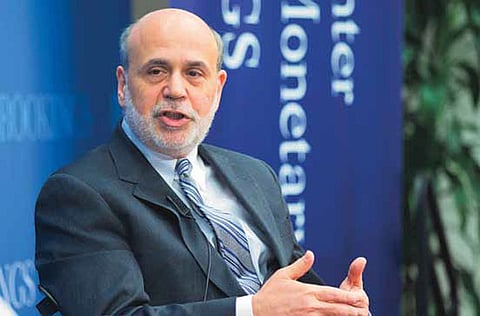Fed expected to further trim bond purchases
Many also fear higher US rates will lead some bond investors to move cash out of emerging markets

Washington: Economists are expecting a string of $10 billion (Dh36.7 billion) monthly reductions in bond purchases to be announced at each Fed meeting this year, concluding with a final $15 billion cut in December.
The Federal Reserve was expected last night (Wednesday) to further reduce its stimulus for the US economy even though that prospect has unsettled global financial markets. The two-day Fed meeting that ended yesterday was the last to be presided over by Ben Bernanke, who is stepping down after eight years as chairman and will be succeeded next week by Vice Chair Janet Yellen. She is expected to stick closely with Bernanke’s policies.
The Fed announced last month that it would pare its monthly bond purchases from $85 billion to $75 billion. And it said that if the economy kept improving, it would likely further slow its bond buying at future meetings. The Fed’s bond purchases have been intended to keep long-term loan rates low to spur spending and economic growth.
Last month, along with the modest trim in its bond purchases, the Fed made clear it plans to keep short-term rates historically low “well past” the time the unemployment rate dips below 6.5 per cent. The rate is now 6.7 per cent.
Managing a slowdown in the Fed’s bond purchases without roiling markets will pose a tough early test for Yellen. Investors have been nervous in part because a pullback in Fed bond buying will likely mean higher rates. Borrowing could weaken as a result.
Currency values
Many also fear that higher US rates will lead some bond investors to move cash out of emerging markets and into the United States to seek higher returns. That fear has depressed currency values and roiled stock markets in a number of developing countries.
The Turkish central bank held an emergency meeting Tuesday and announced it was raising a key rate from 7.75 per cent to 12 per cent to try to reduce inflation and boost its currency, the lira, which had fallen to a record low.
The Fed decided in December to start trimming the bond purchases mainly because of evidence the US economy is strengthening and needs less support from the Fed.
Turmoil in overseas markets has battered the currencies of Turkey, Argentina and other emerging economies. Those economies had previously enjoyed an inflow of investor money.
“Now, those countries are having to deal with a reversal of those flows,” said David Jones, chief economist at DMJ Advisors and the author of a new book on the Fed.
Jones see the market turbulence as a “perfect illustration of the tricky transition that Yellen will have to manage” as the Fed winds down the programs it put in place after the financial crisis erupted in 2008. Still, he doesn’t think the Fed will diverge from the pace of its bond-buying reductions unless market turmoil begins to slow the US economic recovery.
Statistical aberration
Bernanke is ending his tumultuous eight-year tenure at the Fed amid tentative signs of a stronger US economy. Employers created only 74,000 jobs in December, far below the 214,000 average of the previous four months. But many analysts think the lackluster December total marked a temporary pause or a statistical aberration.
Throughout 2013, the Fed bought $85 billion a month in Treasury and mortgage bonds to try to keep long-term rates down to stimulate borrowing by businesses and consumers.
Bernanke’s first mention of a pullback in bond purchases, in mid-2013, triggered a mini-panic in the stock market. Afterward, the Fed stepped up its efforts to assure investors that a pullback in purchases didn’t mean the Fed would soon raise the short-term rates it controls.
Since the recession ended in June 2009, economic growth has remained subpar. Analysts are forecasting a brighter 2014, in part because the federal government will impose less drag this year.
One other reason no surprise is expected from the Fed this week is that it’s undergoing a leadership transition. When Yellen takes over next week, she’ll become the first woman to lead the Fed in its 100-year history.
Sign up for the Daily Briefing
Get the latest news and updates straight to your inbox



